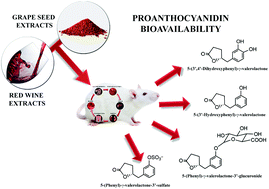Bioavailability of red wine and grape seed proanthocyanidins in rats†
Abstract
This study explored plasma levels and urinary and fecal excretion of metabolites and microbial-derived catabolites over a 24 h period following the ingestion of red wine (RWP) or grape seed (GSP) proanthocyanidin-rich extracts by rats. In total, 35 structurally-related (epi)catechin metabolites (SREMs) and 5-carbon side chain ring fission metabolites (5C-RFMs) (phenyl-γ-valerolactones and phenylvaleric acids), and 50 phenolic acid and aromatic catabolites were detected after intakes of both extracts. The consumption of the RWP extract, but not the GSP extract, led to the appearance of a ∼200 nmol L−1 peak plasma concentration of SREMs formed from flavan-3-ol monomers. In contrast, ingestion of the GSPs, but not the RWPs, resulted in a substantial increase in microbiota-derived 5-carbon side chain ring fission metabolites (5C-RFMs) in plasma. 5C-RFMs, along with low molecular weight phenolic catabolites were detected in urine after ingestion of both extracts. The GSP and RWP extracts had respective mean degrees of polymerisation 5.9 and 6.5 subunits, and the RWP extract had an upper polymer size of 21 subunits compared to 44 subunits for the GSP extract. The differences in plasma metabolite profiles might, therefore, be a consequence of this polydispersity impacting on the microbiota-mediated rates of cleavage of the proanthocyanidin subunits and their subsequent metabolism and absorption. Urinary excretion of phenolic catabolites indicated that 11% of RWPs and 7% for GSPs were subjected to microbial degradation. In all probability these figures, rather than representing the percentage of proanthocyanidins that are completely degraded, indicate partial cleavage of monomer subunits producing a much higher percentage of shortened proanthocyanidin chains. Obtaining more detailed information on the in vivo fate of proanthocyanidins is challenging because of the difficulties in analysing unabsorbed parent proanthocyanidins and their partially degraded flavan-3-ol subunit chains in feces. Further progress awaits the development of improved purification and analytical techniques for proanthocyanidins and their use in feeding studies, and in vitro fecal and bacterial incubations, with radio and/or stable isotope-labelled substrates.

- This article is part of the themed collection: International Conference on Polyphenols and Health (ICPH2019) collection


 Please wait while we load your content...
Please wait while we load your content...